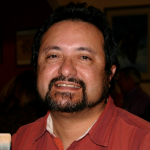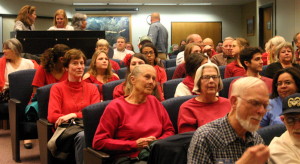
Frank X. Moraga
By Frank X. Moraga / AmigosNAZ
When a developer proposed to build a multistory student housing project in the heart of Flagstaff’s La Plaza Vieja Neighborhood, local residents were a bit perturbed.
How would the project affect the character of the neighborhood, one of the oldest in the city?
How would 500-plus students impact local traffic and safety?
How do you mesh a traditional neighborhood where everyone has known each other for generations with here-today gone-tomorrow college students who have been known to party hardy, causing plenty of headaches for local law enforcement?
That has happened even when a student housing project is located right across the street from the Flagstaff Police Department.

La Plaza Vieja neighborhood residents and opponents to student housing attend a City of Flagstaff Zoning and Planning Commission meeting in early 2014. AmigosNAZ file photo ©2014
Yes, the residents were perturbed, if not downright hostile, packing Flagstaff’s Zoning and Planning Commission and City Council meetings with standing-room-only crowds, often dressed in red to match their rage against a proposed development that would also wipe out affordable housing at a mobile home park.
In the end, the developer pulled the project from the process and has come up with another proposal that would leave the mobile home park alone.
Meanwhile, La Plaza Vieja residents have been busy dusting off the old proposed neighborhood plan in an effort to have a better say in what can and cannot be allowed in the neighborhood.
The first step in that process began on Nov. 12 when a public meeting was held at the High Country Conference Center to discuss updating the neighborhood plan.
The Arizona Daily Sun reported that more than 40 people attended the meeting to update a plan that was put on hold in 2011. Work on the initial plan began in 2008 with that process including six visioning sessions, community design charrettes, and policy discussions with the public, city officials reported in a media release. That plan can be found at http://tiny.cc/laplazavieja
The city’s Comprehensive Planning Division will use the update to align with new and emerging city policies, including the Zoning Code and the Flagstaff Regional Plan 2030.
With several student housing projects already in the pipeline, members of La Plaza Vieja Neighborhood Association and other interested parties in the city are eager to get the process started before another major controversy arises.
“La Plaza Vieja Neighborhood Association asks you to be a part of the process; we need your insight and ideas,” Laura Bustamante-Myers, Neighborhood outreach director, stated in the release. “Please make every effort to attend and participate in the scheduled meetings.”
City planning officials are also eager to give everyone an opportunity to speak their mind. Neighborhood residents, businesses and interested members of the Flagstaff community are encouraged to attend.
“This plan update is an opportunity, not just to address new concerns for the neighborhood,” Sara Dechter, the city’s comprehensive planning manager, stated in a media release. “It is also an opportunity to be proactive and provide solutions that ensure future projects, of any size, are compatible with the neighborhood character.”
Future gatherings are planned, the Sun reported, with a meeting on Wednesday, Jan. 21 to talk about land use and the neighborhood character, followed by a Monday, Jan. 26 meeting to discuss transportation and traffic issues. Both meetings will be held at Our Lady of Guadalupe Church, 224 S. Kendrick St., Flagstaff.
An open house will then be held at the church on Thursday, Jan. 29 to review the updated plan before it goes to the Planning and Zoning Commission. All events are at 6 p.m.
Of course it should go without saying that if residents want to say in how their neighborhood will develop in the years to come, they need to make the effort to attend as many of these meetings as possible.
If opponents of a student housing project can have standing-room-only crowds at previous city meetings, there should be no excuse to have anything less than that at any of the meetings in January.
— Frank X. Moraga, editor/publisher of AmigosNAZ, has served as business editor, director of diversity, city beat and environmental reporter in the newspaper industry. He can be reached at fmoraga@amigosnaz.
